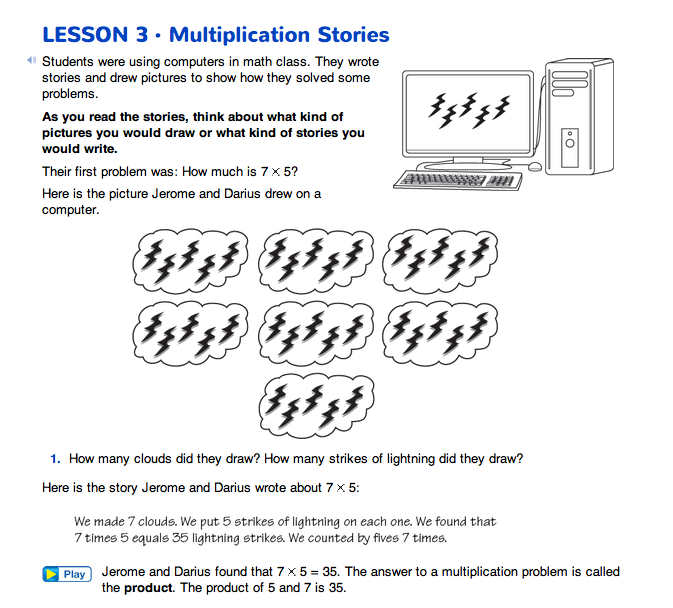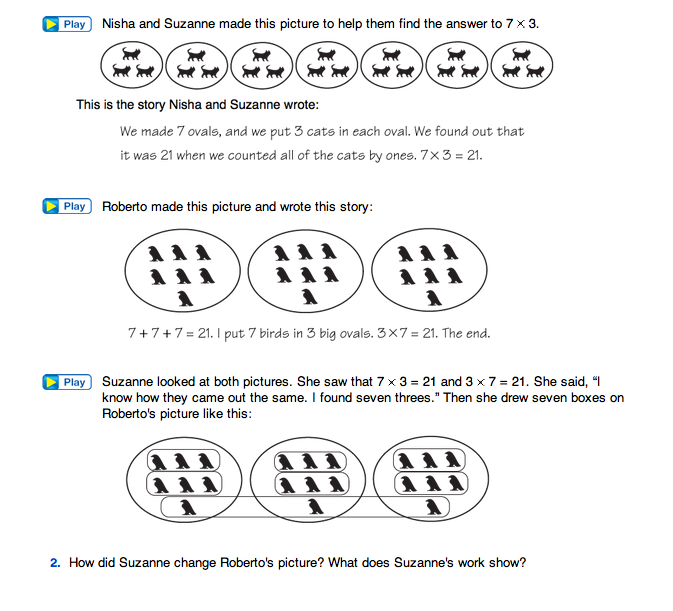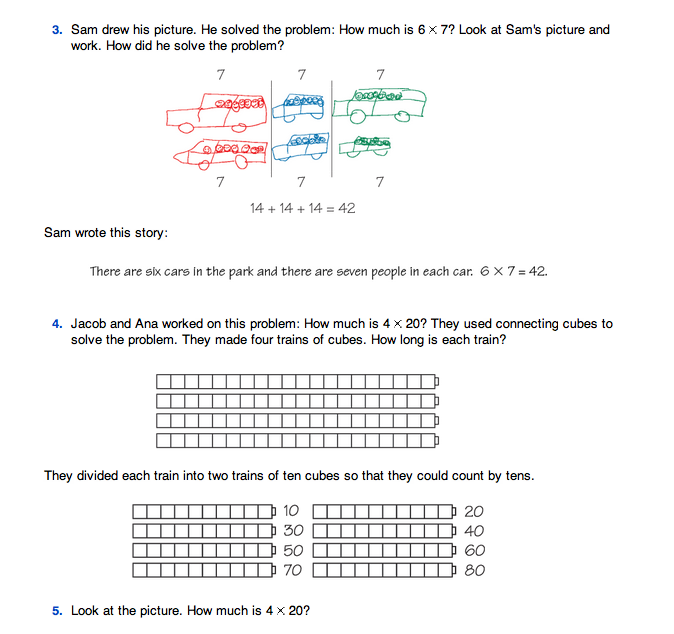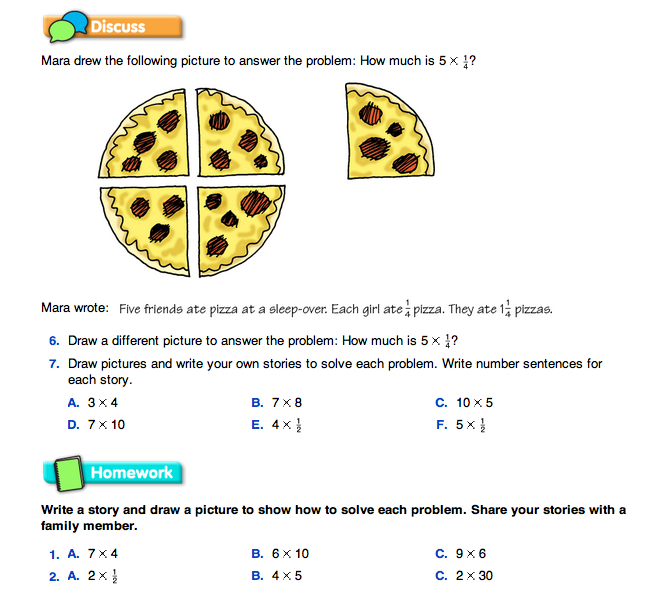Represent Multiplication Stories. This lesson demonstrates one visual model of multiplication—repeated addition. Repeated addition is only one strategy students can use to solve multiplication problems. It is one of the many strategies they will practice that will lead them to fluently multiply and divide within 100.
To begin, read the Multiplication Stories pages in the Student Guide together as a class. These pages show pictures and descriptions that illustrate multiplication problems. Spend adequate time discussing the examples and discussing Questions 1–7 together.
Question 1 introduces the term product (the answer to a multiplication problem). Use it as you deem appropriate when you discuss these problems.
The first three student examples involve only one-digit factors and serve as an introduction to the multiplication facts. Discuss the first two examples, Jerome and Darius's 7 × 5 multiplication story, and Nisha and Suzanne's story depicting 7 × 3. Check to make sure students understand how the multiplication sentence relates to the story. For example, 7 × 5 can mean 7 groups of 5 things, such as 7 clouds each having 5 lightning strikes on them. Each cloud, or group, is an equal-sized group.
Referring back to these examples, ask:
- Jerome and Darius drew a picture showing 7 × 5. Do some clouds have more lightning strikes? (No, each group, or cloud, has an equal number of lightning strikes in them.)
- Nisha and Suzanne drew a picture showing 7 × 3. They have 7 groups of 3 cats. Are all the groups equal? (Yes.)
Factors. In a multiplication problem, the numbers that are multiplied together are called factors. In the problem 3 × 4 = 12, 3 and 4 are the factors. Factors are whole numbers that can be multiplied together to get a number. That is, numbers that divide a number evenly. For example, 1, 2, 3, 4, 6, and 12 are all the factors of 12.
Multiples. A number is a multiple of another number if it is evenly divisible by that number. For example, 12 is a multiple of 2 since 2 divides 12 evenly. When we skip count by 2s, we call out the multiples of 2: 2, 4, 6, 8, 10, etc.
Continue with Roberto's multiplication story showing 3 groups of 7 birds. This example, as well as the one in Question 3, shows how multiplication problems can be solved with repeated addition.
After discussing Roberto's multiplication story, take time to ask:
- How is 7 + 7 + 7 the same as 3 × 7? (They both equal 21. They both show the 3 groups of seven.)
- Show how you could solve Jerome and Darius's problem, 7 × 5, using repeated addition. (5 + 5 + 5 + 5 + 5 + 5 + 5 = 35)
- Nisha and Suzanne drew 7 groups of 3 cats. How could you solve 7 × 3 using repeated addition? (3 + 3 + 3 + 3 + 3 + 3 + 3 = 21)
- Is 7 × 3 = 3 × 7 a true multiplication sentence? (Yes. Both sides of the equation show 21.)
- Nisha and Suzanne's drawing looks different than Roberto's, but they both show 21 objects. How is 7 × 3 different from 3 × 7? (7 × 3 shows 7 groups of 3, 3 × 7 shows 3 groups of 7.)
- How are they the same? (They both equal 21.)
Discuss Question 2, highlighting the difference between 7 groups of 3 and 3 groups of 7, and Question 3, showing another example of repeated addition.
At this point, do not place too much emphasis on the order of the factors in a multiplication sentence. It is standard practice to associate the number sentence 3 × 4 = 12 with the sentence: 3 groups of 4 equals 12. However, some students might write 4 × 3 = 12. Since multiplication is commutative, order does not matter.
Use labels to clearly show the relationship between a number sentence and a story. For example:
3 groups × 7 cats = 21 cats
or
3 cats × 7 groups = 21 cats
Questions 4–5 involve one factor that is a multiple of ten. Being able to efficiently multiply by tens is an important skill used when estimating, while doing mental math, and while solving more complex multiplication and division problems. After you discuss these questions, ask students to skip count by tens.
- What do you notice about the numbers we say when we skip count by tens? (They all end in zero.)
Display 2 × 20, 2 × 30, 2 × 40, 2 × 50, 2 × 60, 2 × 70, and then 50 × 3, 50 × 4, 50 × 5, and so on, and ask:
- What do you notice when you multiply a number times a multiple of ten—a number that ends in zero? (The products are all numbers that you say when you skip count by tens. They all end in zero, too.)
- Explain an easy way to multiply a number by a multiple of ten. (Possible response: Cover the zero and think about multiplying by tens. For example, for 2 × 20, cover the zero and think 2 times 2 tens equals 4 tens, or 40.)
Represent Multiplication Stories with Fractions. The last student example in Multiplication Stories includes one factor that is a fraction. Discuss Mara's pizza story. Remind students that fractions are parts of a whole, and in Mara's story, she divides her pizzas into 4 equal pieces. A pizza cut into 4 equal pieces becomes 4 fourths of a pizza.
- How many fourths of pizza make one whole pizza? (4 fourths)
- Mara's story shows 5 × 1/4 . Show how you could solve the problem using repeated addition.
(1/4 + 1/4 + 1/4 + 1/4 + 1/4 = 11/4)
- What else could we divide into four equal pieces, or fourths? (Possible responses: sandwich, cookies, floor tile, cake, square blanket, piece of paper, book, mile)
- If we cut something into 2 equal pieces, what would we call each piece? (a half)
- How many halves make one whole? (2 halves)
- What else could we divide into 2 equal pieces, or halves? (Possible responses: orange, tennis ball, inch, day, hour, dollar, cup, football field)
Allow students to complete Question 6, which asks them to draw a different picture to show 5 × 1/4 . Have students share their pictures and discuss the strategies used to solve the problem. As a class, draw a picture that shows 7 × 1/2 = 3 1/2.
- Compare the whole numbers in these multiplication sentences to the products. What do you notice? (When you multiply a whole number by a fraction, the product is smaller than the whole number.)
- Does this make sense? (Yes. When we multiply two whole numbers, the product is bigger than the numbers we are multiplying. But when we multiply a number by a fraction, which is less than 1, the product will be smaller than the whole number.)
Have students work independently on Question 7, drawing pictures and writing stories to solve each problem. Remind them to write number sentences for each of their stories. Students should share their stories and pictures when finished.
Traditionally, children multiply whole numbers for a long period of time before they are introduced to multiplication with fractions. By learning multiplication exclusively with whole numbers, children develop the erroneous notion that the product is always larger than its factors—in short, that multiplying always makes “bigger” numbers. By including fractions in these problems, students learn early that multiplication can also produce smaller numbers. Problems with fractions can be solved using strategies similar to those used to solve the first problems—drawing pictures and using repeated addition.
















